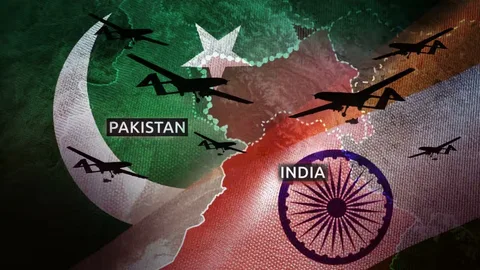India-Pakistan Conflict 2025: Legal Dimensions and Regional Implications

Introduction
The India-Pakistan relationship has been stressful for both countries since 1947 because of the Kashmir. The recent escalation, marked by the deadly Pahalgam terror attack on April 22, 2025, and India’s retaliatory “Operation Sindoor” on May 7, 2025, has brought the conflict into sharp focus. This article explores the legal aspects of the ongoing crisis, the role of international and domestic laws, and the broader implications for regional stability, drawing on principles of international humanitarian law (IHL), the UN Charter, and India’s legal framework.
Current State of the Crisis and the LoC
The latest flashpoint in the relations between India and Pakistan occurred when militants, allegedly linked to Pakistan-based Lashkar-e-Taiba, attacked a tourist convoy in Pahalgam, Kashmir, killing 26 people—the deadliest terror strike in India since 2008. India responded with ‘Operation Sindoor’, launching 24 precision missile strikes on terrorist camps in Pakistan and Pakistan-occupied Kashmir (PoK). India’s Foreign Secretary Vikram Misri described the strikes as “controlled, precise, measured, and non-escalatory,” targeting terrorist infrastructure in response to Pakistan’s alleged sponsorship of the attack.
Historically, the point of conflict in Indo-Pak relations has mainly been regarding the Line of Control (LoC) which is a de facto military border between the Indian-administered and Pakistani-administered parts of Jammu and Kashmir. It was established following the 1971 Indo-Pakistan War and formalized in the 1972 Simla Agreement, which converted the ceasefire line into the LoC. Crossing the LoC by military forces of either India or Pakistan generally constitutes a violation of the Shimla Agreement as it deters any unilateral alteration of the line. While it serves as the de facto border, it is not a legally recognized international boundary with both the countries claiming territories on either side of the border.
International Law and the Use of Force
The UN Charter, particularly Article 2(4), prohibits the use of force against a state’s territorial integrity or political independence, a peremptory norm of international law. Exceptions exist under Article 51, which permits self-defence in response to an “armed attack,” and Chapter VII, which allows UN Security Council-authorized force.
India justifies ‘Operation Sindoor’ under Article 51, arguing that the Pahalgam attack, supported by Pakistan, constitutes an armed attack. In the case of US v. Nicaragua, the International Court of Justice (ICJ) clarified that an armed attack by non-state actors must be of “sufficient gravity” and attributable to a state to trigger self-defence. India asserts that Pakistan’s backing of Lashkar-e-Taiba meets this threshold.
Defining Aggression and its Response
UNGA Resolution 3314 (1974) defines aggression and establishes that the first unlawful use of force gives rise to a presumption of aggression. India alleges that Pakistan’s sponsorship of LeT proxies satisfies this threshold.
International Humanitarian Law (IHL), codified in the Geneva Conventions, governs the conduct of armed conflicts. Key principles include:
- Distinction: Parties must differentiate between combatants and civilians, targeting only military objectives.
- Proportionality: Attacks must not cause excessive civilian harm relative to the military advantage gained.
- Necessity: Military actions must be limited to achieving legitimate objectives, avoiding unnecessary suffering.
India claims its strikes adhered to these principles, targeting only terrorist camps and minimizing civilian casualties. However, Pakistan’s alleged support for terrorism, if proven, could violate IHL and UNGA Resolution 3314, which defines aggression as the use of armed force against another state’s sovereignty, including sponsoring armed groups.
India’s Justification for Retaliation
In the context of ongoing hostilities, we have to consider Article 53 of UN Charter which states that:
“Nothing in the present Charter shall impair the inherent right of individual or collective self-defence if an armed attack occurs against a Member of the United Nations, until the Security Council has taken measures necessary to maintain international peace and security.”
This article is widely understood to codify a pre-existing, “inherent right” to self-defence that exists under customary international law, even independent of the Charter itself. A crucial trigger for the lawful exercise of this right under Article 51 is the occurrence of an “armed attack” against a member state.
India justifies its actions in response to the Pahalgam attack based on the right to self-defence under Article 51 of the UN Charter. India argues that the attack, supported by Pakistan-based terrorist groups, constitutes an “armed attack” necessitating a response to protect its security and deter future attacks. India has also emphasized that its actions under “Operation Sindoor” were measured, non-escalatory, proportionate, and responsible and targeted against terrorist infrastructure, focusing on dismantling it and not against the common people of Pakistan.
India’s Domestic Legal Framework
India’s response is guided by its Constitution and military doctrine. Article 355 imposes a duty on the Union to protect states from external aggression. India’s evolving military doctrine, shifting from “deterrence by denial” to “deterrence by punishment,” reflects a proactive stance against cross-border terrorism. The Ministry of Defence and Armed Forces operate under dynamic Rules of Engagement (ROE), allowing flexibility in response to threats like the Pahalgam attack. The Supreme Court, while typically deferring to the Executive on national security, can review actions to ensure constitutional compliance, particularly regarding fundamental rights.
In a declared war, India’s Constitution grants the Union extensive emergency powers under Article 352, including suspending fundamental rights, extending executive control over states, and legislating on state matters. The President, as Supreme Commander of the Armed Forces under Article 53(2), oversees military operations.
The Indus Waters Treaty Suspension
The Indus Waters Treaty (IWT) was brokered by the World Bank and signed in 1960, allocating water from the Indus River system between India and Pakistan. Following the Pahalgam attack, India put the Treaty in abeyance, suspending its participation, raising concerns about water security for Pakistan which is heavily reliant on the Indus for agriculture and other needs. The importance of the Treaty can be attributed through Pakistan’s declaration, calling the suspension an “Act of War.” Legally, unilateral suspension without a material breach by Pakistan may violate the Vienna Convention on the Law of Treaties. For India, the suspension will enable to increase hydro-power and control floods over the Western rivers (Jhelum, Chenab, Indus). However, limited infrastructure currently restricts India’s ability to fully exploit this advantage.
Nuclear Risks and International Law
India and Pakistan both have nuclear facilities that is a cause of concern. The ICJ’s 1996 Advisory Opinion on ‘Legality of the Threat or Use of Nuclear Weapons’ found no universal prohibition on their use but noted that such use would generally be contrary to the principles and rules of international humanitarian law due to their indiscriminate effects and potential to cause widespread, long-term, and severe damage.
India’s Nuclear Policy is centred around the principle of “No First Use” (NFU) and “Credible Minimum Deterrence” in contrast with Pakistan’s ambiguous stance, which includes potential use of tactical nuclear weapons to counter conventional threats emerging as a hybrid mix incorporating various elements of NATO’s nuclear strategies of “Mutually Assured destruction.” In any situation, nuclear escalation by either country would result in breach of Article 2(4) of the UN Charter and violation of humanitarian principles.
International Judicial Accountability
The International Criminal Court (ICC) prosecutes individuals for war crimes, genocide, and aggression, while the ICJ resolves state disputes. India, not a party to the Rome Statute, is outside ICC jurisdiction. Historical precedents, like the Nuremberg and Tokyo Tribunals, established accountability for aggressive wars and war crimes committed by individuals who were Axis leaders. The Principle VI established under Nuremberg Trial which was also applied in the Tokyo Trials set out the crimes which were punishable under international law. These include; a) Crimes Against Peace, b) War Crimes, and c) Crimes against Humanity.
Repercussions for Breach of IHL
Under international law, aggression is considered the most serious crime against peace and security. UN General Assembly Resolution 3314 defines “aggression as the use of armed force by a state against the sovereignty, territorial integrity, or political independence of another state.” In the context of the ongoing Indo-Pak conflict, Pakistan’s alleged support for terrorism could trigger state responsibility under the Articles on Responsibility of States for Internationally Wrongful Acts (ARSIWA), potentially leading to reparations (the action of making amends for a wrong one has done, by providing payment or other assistance to those who have been wronged) or sanctions. However, geopolitical divisions, particularly China’s support for Pakistan, limit UN Security Council action.
Bilateral Treaties between India and Pakistan
India and Pakistan have entered into various bilateral agreements over the years, most notable being the Karachi Agreement (1949), Liaquat-Nehru Pact (1950), Indus Water Treaty (1960), Tashkent Declaration (1965), Simla Agreement (1972), Non-nuclear Aggression Agreement (1988) and Lahore Declaration (1999) .
Further, both countries are parties to several global conventions, most notably the four Geneva Conventions of 1949, which establish the fundamental rules of international humanitarian law. However, India has not ratified the Additional Protocols I and II to the Geneva Conventions, while Pakistan has signed but not ratified Protocol I.
Is Extradition between India and Pakistan Possible
India and Pakistan lack an extradition treaty, complicating efforts to address terrorism. India’s request for Hafiz Saeed’s extradition in 2023 failed because of this. Extradition treaties, governed in India by the Extradition Act, 1962, require dual criminality and a prima facie case. Without a treaty, cooperation depends on domestic laws and international norms. Bilateral agreements like the Simla Agreement (1972) and Indus Waters Treaty remain critical, though the latter’s suspension underscores the fragility of such frameworks.
Lessons from Global Conflicts
Recent wars in Ukraine and Israel-Palestine highlight the challenges of applying IHL in conflicts involving non-state actors and self-defence claims. Both Russia and Israel invoked Article 51 to justify actions, a precedent India mirrors in its response to Pakistan. These conflicts underscore the need for proportionality, distinction, and accountability to prevent escalation and civilian harm.
Conclusion
The India-Pakistan conflict, reignited by the Pahalgam attack, tests the boundaries of international and domestic law. India’s Operation Sindoor, justified as self-defence, aligns with Article 51 but raises questions about proportionality and escalation. The suspension of the Indus Waters Treaty risks weaponizing a vital resource, while nuclear capabilities loom large. As both nations navigate this crisis, adherence to IHL, respect for bilateral agreements, and international cooperation are crucial to prevent further destabilization. The key takeaway for India is the urgent need for unity and restraint to avoid a broader conflict, fostering a “New India” resilient in adversity and brave in challenges.
JAI HIND!
Sushila Ram Varma, Advocate
Chief Consultant, The Indian Lawyer & Allied Services
Assisted by Saharsh Singh, Intern,
4th Year, National Law Institute University, Bhopal





































Leave a Reply